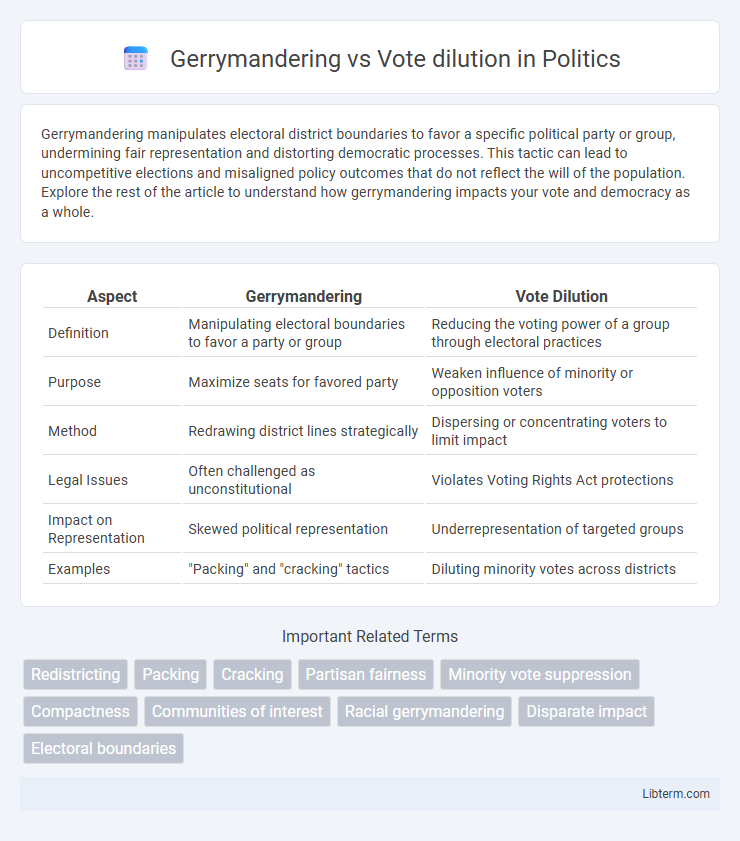Gerrymandering manipulates electoral district boundaries to favor a specific political party or group, undermining fair representation and distorting democratic processes. This tactic can lead to uncompetitive elections and misaligned policy outcomes that do not reflect the will of the population. Explore the rest of the article to understand how gerrymandering impacts your vote and democracy as a whole.
Table of Comparison
| Aspect | Gerrymandering | Vote Dilution |
|---|---|---|
| Definition | Manipulating electoral boundaries to favor a party or group | Reducing the voting power of a group through electoral practices |
| Purpose | Maximize seats for favored party | Weaken influence of minority or opposition voters |
| Method | Redrawing district lines strategically | Dispersing or concentrating voters to limit impact |
| Legal Issues | Often challenged as unconstitutional | Violates Voting Rights Act protections |
| Impact on Representation | Skewed political representation | Underrepresentation of targeted groups |
| Examples | "Packing" and "cracking" tactics | Diluting minority votes across districts |
Understanding Gerrymandering and Vote Dilution
Gerrymandering involves manipulating electoral district boundaries to create an unfair political advantage, often resulting in vote dilution where the voting power of a particular group is weakened. Vote dilution occurs when the impact of a group's votes is minimized through tactics like cracking, which spreads voters across multiple districts, or packing, which concentrates them into one district. Understanding both concepts is essential for addressing electoral fairness and protecting minority voting rights under laws like the Voting Rights Act.
Historical Context of Gerrymandering
Gerrymandering originated in 1812 when Massachusetts Governor Elbridge Gerry approved a district map designed to benefit his party, leading to oddly shaped electoral districts. Historically, this manipulation of district boundaries has been employed to entrench political power and marginalize opposition groups. Vote dilution occurs when such redistricting tactics minimize the voting strength of certain communities, particularly racial or political minorities, undermining fair representation.
Defining Vote Dilution: Key Concepts
Vote dilution occurs when the influence of a particular group of voters is weakened, often through electoral mechanisms that reduce their effective representation. Techniques such as packing, cracking, and stacking redistribute or disperse voter populations to minimize their impact on election outcomes. Understanding vote dilution is essential for identifying unfair practices that undermine the principle of equal representation under the law.
Legal Frameworks Governing Redistricting
Legal frameworks governing redistricting address gerrymandering and vote dilution primarily through constitutional provisions and federal statutes such as the Voting Rights Act of 1965. Courts evaluate district maps based on criteria like equal population, racial fairness, and the protection of minority voting rights to prevent discriminatory practices. Judicial oversight ensures adherence to these legal standards, aiming to maintain electoral integrity and equitable representation.
Mechanisms of Gerrymandering: Tactics and Techniques
Gerrymandering employs tactics such as "cracking," where voters of a particular type are split across multiple districts to dilute their influence, and "packing," which concentrates opposing voters into a single district to minimize their impact elsewhere. These techniques manipulate district boundaries, undermining fair representation and leading to vote dilution by weakening the electoral power of targeted groups. Sophisticated software and demographic data further enhance the precision of gerrymandering, making it a potent tool for distorting democratic outcomes.
How Vote Dilution Undermines Political Representation
Vote dilution undermines political representation by dispersing or concentrating minority votes to minimize their influence in elections. This strategic manipulation weakens the electoral power of specific groups, resulting in their diminished ability to elect preferred candidates. Consequently, vote dilution erodes the principle of fair representation and distorts the democratic process.
Impact on Minority Communities
Gerrymandering often results in vote dilution by manipulating electoral district boundaries to weaken the voting power of minority communities, effectively limiting their political representation and influence. This practice can segregate minority voters into a few districts (packing) or spread them thinly across many districts (cracking), reducing their ability to elect candidates of choice. Consequently, minority communities face systemic barriers to achieving equitable political participation and policy advocacy.
Case Studies: Notable Examples in the U.S.
The landmark Supreme Court case Shaw v. Reno (1993) addressed vote dilution by ruling that racial gerrymandering violating the Equal Protection Clause was unconstitutional, emphasizing fair representation. Another notable example is the 2018 Pennsylvania redistricting case, where courts struck down gerrymandered maps that diluted urban votes in favor of rural districts, highlighting partisan vote dilution concerns. These cases illustrate how judicial interventions tackle both racial and partisan gerrymandering to protect voting rights and uphold democratic principles.
Reform Efforts and Legislative Solutions
Reform efforts addressing gerrymandering and vote dilution emphasize the establishment of independent redistricting commissions and the implementation of clear, non-partisan criteria for district boundaries. Legislative solutions such as the For the People Act and the John Lewis Voting Rights Advancement Act aim to enhance transparency, enforce equal representation standards, and prevent manipulation of electoral maps that weaken minority voting strength. These reforms seek to promote fairer elections by reducing political bias and ensuring that district lines reflect true demographic and community interests.
The Future of Fair Representation: Challenges and Opportunities
Gerrymandering and vote dilution remain critical challenges threatening fair political representation by manipulating district boundaries to diminish minority voting power. Advances in data analytics and legal frameworks offer opportunities to detect and combat these practices, promoting equitable electoral maps. Continuous innovation in algorithmic redistricting and voter education is essential to safeguard democratic processes and ensure proportional representation in future elections.
Gerrymandering Infographic

 libterm.com
libterm.com